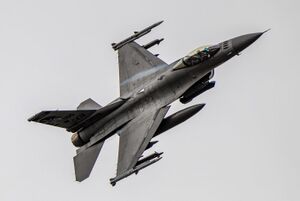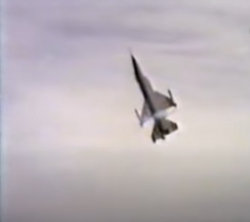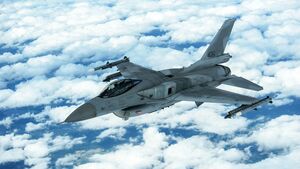JAS-16 Raven: Difference between revisions
(Created page with "{|{{Infobox aircraft begin |name = JA16 Raven II |image = Image:EF161NGSnowsnake.jpg |caption = An Acrean Air Force JA16NG 'Kingraven' in 2010....") |
No edit summary |
||
| Line 12: | Line 12: | ||
|first flight = 13 February 1971 | |first flight = 13 February 1971 | ||
|introduction = | |introduction = | ||
|introduced = 2 May | |introduced = 2 May 1976 | ||
|retired = | |retired = | ||
|status = In active service | |status = In active service | ||
|primary user = {{flagicon|Acrea}} [[Acrean Air Force|Royal Acrean Air Force]] | |primary user = {{flagicon|Acrea}} [[Acrean Air Force|Royal Acrean Air Force]] | ||
|more users = | |more users = | ||
|produced = | |produced = 1971-Present | ||
|number built = | |number built = | ||
|program cost = | |program cost = | ||
Revision as of 16:06, 22 May 2023
| JA16 Raven II | |
|---|---|

| |
| An Acrean Air Force JA16NG 'Kingraven' in 2010. | |
| Role | Air superiority fighter |
| National origin | |
| Manufacturer | MDA SE |
| Design group | MDA |
| First flight | 13 February 1971 |
| Introduction | 2 May 1976 |
| Status | In active service |
| Primary user | |
| Produced | 1971-Present |
The MDA JA16 Raven is a single-seat, single-engined 4th generation multirole fighter designed by MDA SE for the Royal Acrean Air Force. Designed as a lightweight multirole fighter, the Raven became a highly versatile aircraft capable of a multitude of combat operations including ground attack, while retaining the ability to excel in its flight performance characteristics in air-air operations. It is well known not only for its versatility, but its low procurement and operating costs which make it an economic fighter.
Incorporating contemporary advanced avionics, it was the first to use several technologies and features that are now common on Acrean aircraft, such as relaxed stability and fly-by-wire, as well as re-orientation of the pilot to help with sustaining high-g loads. Current variants in service have been heavily modernised, with old systems ripped out and completely replaced. They feature redesigned cockpits with high-resolution LCD displays, sensor fusion, updated avionics thrust vectoring engines, and advanced electronic countermeasure systems all developed in subsequent fighter programs. Currently in the process of being replaced, some Ravens will be maintained in reserve or training squadrons. Their retention is intended to retain institutional and practical knowledge, as a very large number of JA16s remain in storage as war reserve.
Development
Development of a lightweight fighter to replace the EF-105 began in the mid 1960s, with a set of requirements being laid out for a new light, single-engine, single-seat tactical fighter.
The original MDA prototype first tested in 1969 was a purebred short-range, supreme dogfighting aircraft. Lacking a long-range radar, its armament consisted only of six infrared missiles. Although performance of the aircraft was considered exceptional, its capabilities left something to be desired. Subsequent prototypes were fitted with a longer-ranged X-band pulse-doppler radar , with the airframe slightly enlarged and strengthened to accommodate this. With testing completed in 1977, the new prototypes were considered satisfactory. The first examples were delivered to squadrons in 1978.
Naval aviation officials later sought their own new fighter after a perceived gap in capability due to the lack of a dedicated air superiority platform. The requirement found a cost-effective but compromised solution in a naval variant of the Raven introduced in 1981. The most substantial changes included enlarging and strengthening the airframe to suit carrier operations and increase fuel capacity. Although outfitted to be capable of carrier operations, the naval Raven was considered to be lacking in range compared to older Lycan fighters, necessitating the use of external fuel stores to make up the difference and limiting both the performance and payload of the aircraft. Tandem-seat variants of the Raven better suited for multirole operations for both the Air Force and the Navy were developed shortly after their original variants entered service.
Design
Overview
The JA16 Raven is a single engine, highly maneuverable, multirole tactical fighter. Although originally envisioned as a lightweight tactical fighter with a primary focus of air defence, it rapidly evolved into a capable multirole platform. It was designed to be lightweight, cost effective, and easy to maintain. Following its design philosophy, the aircraft is lightweight and nimble, and uses its size and weight in combination a powerful engine and advanced flight control systems to achieve exceptional kinematic performance. As originally equipped, it used advanced avionics derived from the EF/A-121. Since its introduction, the JA16 has been iterated on repeatedly to update it with ever more capable systems. Although upgradability was not a conscious design goal, by its simple-to-maintain and accessible nature the Raven has proven to be incredibly conducive to receiving upgrades; aside from updated major avionics components such as radars and the addition of IRST systems, the JA16 has received upgrades such as conformal fuel tanks, datalink and networking suites, new cockpit designs, electronic warfare systems, and engines.
On the E and NG variants of the aircraft, major radar and sensor systems overhauls were implemented. The Raven's sensors and computer systems constitute the most extensive parts of the aircraft's upgrades. Modern Ravens carry an AESA radar, complimented by an IRST equipped with a magnified long-range optical sight to aid in long range identification, an electronic countermeasure system, and SAIRST/DAS consisting of high-resolution infrared sensors distributed around the airframe to provide full spherical coverage. The SAIRST and the aircraft's RWR provide detection of both infrared and radar-guided missile launches, and the SAIRST also directs infrared imaging countermeasure against incoming infrared missiles. The aircraft utilises data link to share information gathered through its variety of sensors with both friendly Air Force and Navy aircraft, and an electronic warning and countermeasure system is integral to both airframes enabling them to target and jam hostile radars and radar-guided missiles.
Flight Characteristics
The JA16 was one of the first production aircraft in Tyran with an intended relaxed stability design. As a consequence of of its negative stability, the JA16 used advanced fly-by-wire flight control systems to counter the aircraft's tendency to depart from controlled flight. The JA16 relies solely on its fly-by-wire, with no hydraulic or mechanical linkages between the pilot's controls and the aircraft's control surfaces. The flight control systems incorporate limiters to prevent unwanted flight behaviours such as slip, adverse yaw, or high angles-of-attack which cause the aircraft to lose directional stability and controllability. Early variants of the JA16A demonstrated a loss of stability at higher angles of attack, and were at risk of departing flight. Consequently the flight control systems limited the pilot to prevent such an occurence. The JA16A was limited to 25 degrees AOA. Consequently, the JA16 had an larger minimum turn radius compared to contemporary high-alpha capable aircraft such as the EF-168 Viper which could retain good controllability at up to 40 degrees of alpha, however possessed an excellent turn rate of up to 28 degrees per second at corner airspeed. It also possesses excellent energy maneuvering characteristics, able to both maintain airspeed well and regain lost airspeed exceptionally quickly.
The JA16's flight characteristics changed dramatically with the introduction of the JA16C in 1984. The Block II incorporated massive changes to the airframe and powerplant. It fitted the EJ-900-85 engine, an improvement over the EJ-900 which already provided a major increase in thrust both in and out of reheat over the JA16A's EJ-820 series engines. The EJ-900-85 was fitted with the MATV multi-axis thrust vectoring system, which used a nozzle with actuated divergent flaps to provide thrust vectoring. The introduction of MATV required a total overhaul of the flight control systems. Altogether, these changes radically altered the flight characteristics of the Raven in the slow-speed and high-alpha regime, with test pilots describing Ravens equipped with MAVS as feeling like a different plane. The aircraft's slow speed performance likewise improved drastically, with thrust vectoring enabling much greater nose authority at airspeeds where the Raven proved to be poorly responsive previously. During flight testing, a MATV-equipped JA16C managed to sustain flight at nearly 90 degrees AOA. Subsequent variants of the Raven following the initial C-series have retained and improved upon these systems.
Although the thrust-vectoring equipped Ravens demonstrated extraordinary performance, low-speed and high alpha capability were only a secondary goal of equipping them with thrust vectoring. The primary goal was maximising the Raven's already excellent high-speed performance. The use of thrust vectoring was primarily intended to maximise the airframe's aerodynamic efficiency by using a mixture of thrust vectoring and control surface manipulation to minimise the amount of drag being produced by the fighter during maneuvers.
Avionics
Operational History
Refusal War
Zemplen War
Midsummer War
Variants
- EF 161A/B: The JA16A (single seat) and JA16B (two-seat) were the original production aircraft introduced into service in 1974.
- EF 161C/D: The JA16C (single seat) and JA16D (two seat) variant which entered service in 1983 introduced an improved radar, improved digital flight control systems, and better avionics. The C model also introduced the capability to use an improved IRST, though it was rarely fitted to production aircraft. An additional two hardpoints were included on the sides of the air intake, primarily intended for use with targeting pods. The aircraft was fitted with the EJ-900-84 engine. Later production blocks introduced aerodynamic improvements as well as the EF-900-89 engine which was the first to introduce thrust vectoring with the multi-axis MATV system.
- EF 161E/F: Upgrade package introduced in 1998 boasting a new EJ-915 engine and avionics upgrades- systems improvements of the E included a new IRST system which was fitted standard to the airframe, new electronic warfare, new GPS systems, and improvements to the cockpit displays with higher resolution screens and replacement the majority of older instrument displays with an additional two MFD screens along the center pedestal of the cockpit.
- EF 161NG: End-of-life update introduced in 2010 to extend the JA16's service life into the 2020s.
- EF 161S: Introduced as an overhaul upgrade package to the JA16E to fit it with new systems to perform as a 4.5 generation aggressor.
Operators
Current Operators
Specifications (JA16NG)
General Characteristics
- Crew: 1
- Length: 15.06 m
- Wingspan: 9.96 m
- Height: 4.9 m
- Wing Area: 28 m²
- Empty Weight: 8,600 kg (18,960 lbs)
- Fuel Capacity: 4,560 kg (10,053 lbs)
- Powerplant: 1 × MDA EJ-915 afterburning turbofan, 90 kN (20,233 lbf) dry thrust, 145 kN (32,500 lbf) reheat
Performance
- Maximum Speed: Mach 2.1 at high altitude
- Mach 1.2 at sea level
- Mach 1.5 supercruise at altitude
- Service Ceiling: In excess of 19,000 m



